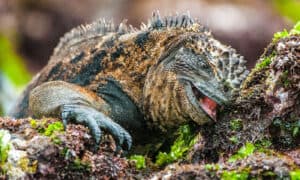The African fat-tailed gecko (Hemitheconyx caudicinctus) is a ground-dwelling gecko that is becoming a fan favorite for new reptile owners. They require little maintenance and with a proper diet, they can experience a long lifespan. These geckos have been show to live longer lives in a safe and well-constructed terrarium than in the wild. Caring for any lizard is less about activity level, but ensuring their home has everything they need to thrive.
We are going to highlight how long African fat-tailed geckos can live, methods to keep them healthy, and why their lifespan is better in captivity than in the wild.
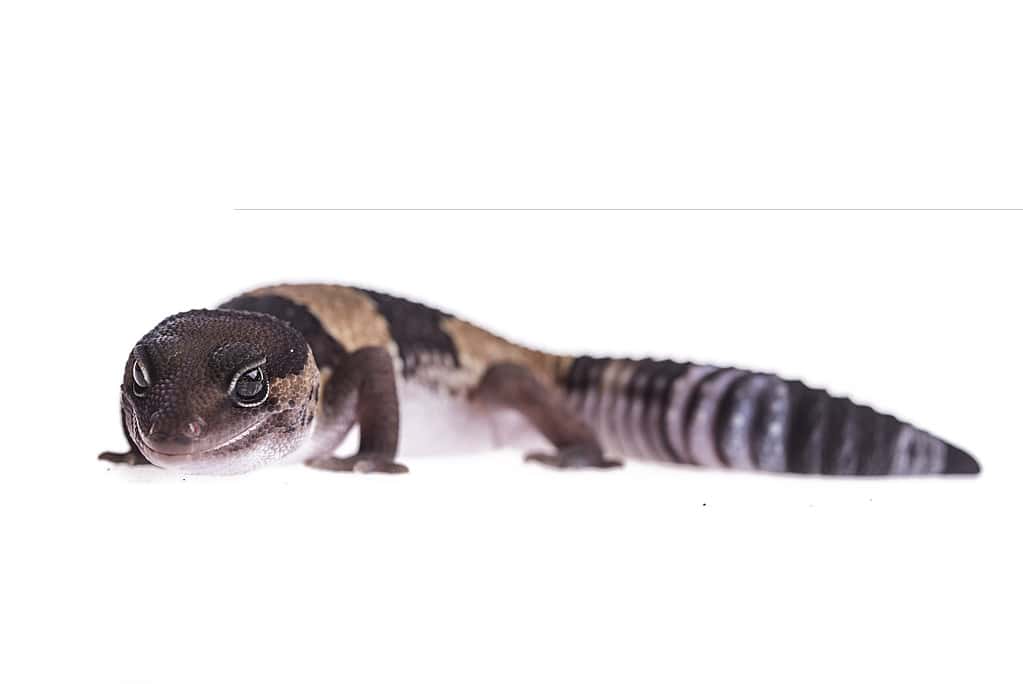
It is not by coincidence that these geckos live longer in captivity.
©Kaan Sezer/iStock via Getty Images
African Fat-Tailed Gecko Lifespan
On average, an African fat-tailed gecko can live anywhere between 10-25 years. This wide range is simplified when addressing where they are living and suitable habitat.
In the wild, they can live anywhere from 10-18 years.
In captivity, they can live from 15-20 years.
African Fat-Tailed Gecko in Captivity
It is not by coincidence that these geckos live longer in captivity. Whether they are in zoos or a loving home, a home specializing for them is the safest place for them as the wild offers numerous dangers and threats.
In captivity, they do not have any natural predators such as birds, snakes, or large spiders trying to hunt them. They can eat their fill with a healthy diet of protein and vitamin supplements, which could be more than what they may find in the wild.
If there is a medical issue with a gecko, exotic animal veterinarians are capable of addressing the situation quickly and providing support.
A clean terrarium reduces the risks of bacteria or diseases from spreading, allowing them an overall healthier and longer life.
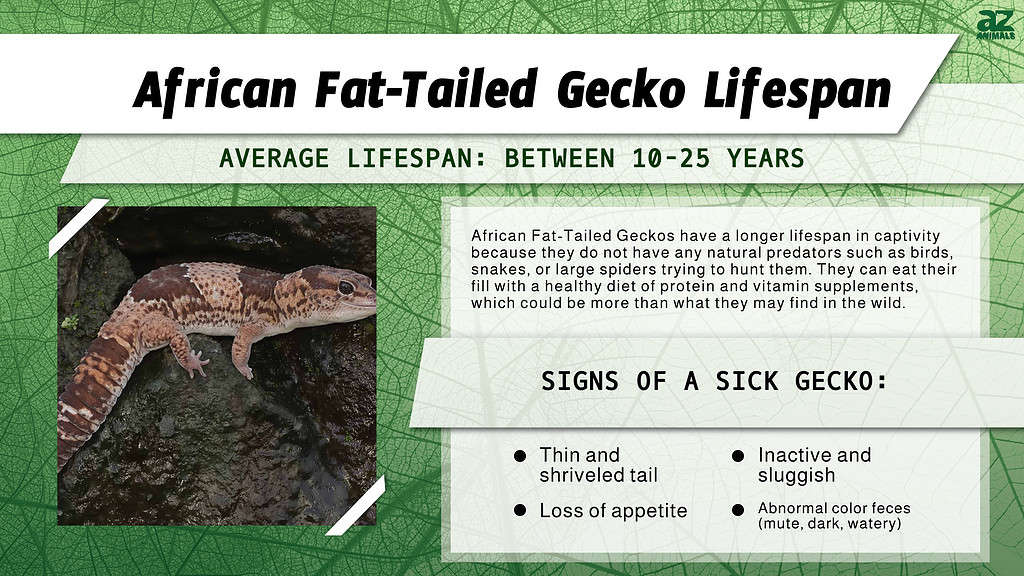
Natural Habitat of African Fat-Tailed Geckos
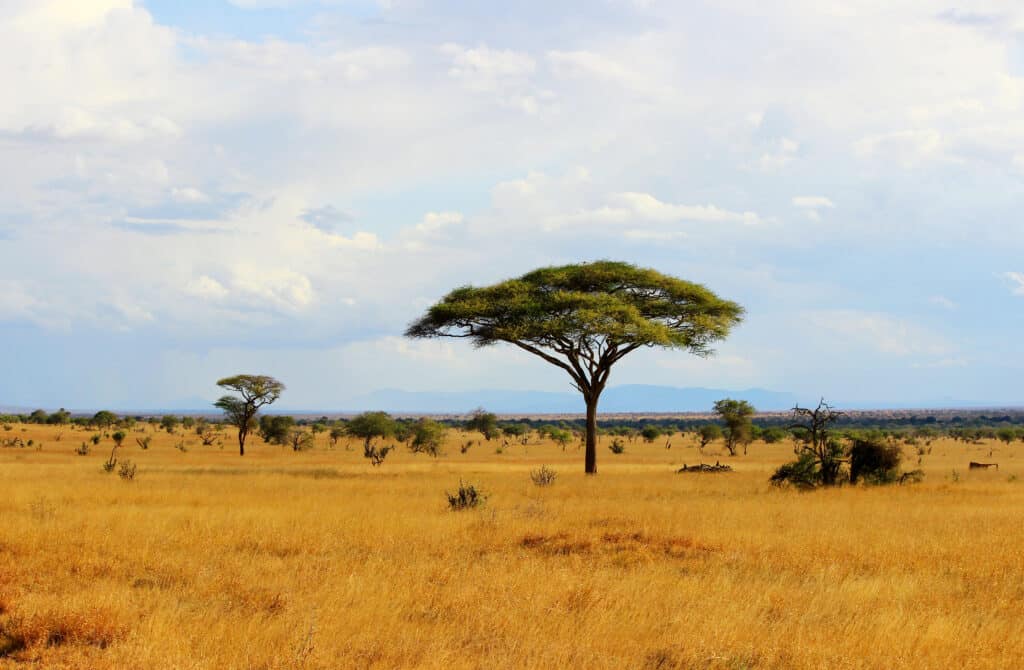
In the wild, these lizards can be naturally found in West Africa and as far South as Cameroon. The region is a large savannah with many rivers and desert plains with dry and hot air.
To avoid the daytime heat and predators, they dig holes in the ground to create a humid cave where they rest during the day, coming out at night to hunt insects.
Appearance

A healthy gecko with brown and beige spots with the iconic fat tail.
©iStock.com/Ken Griffiths
They are relatively small, reaching 7-8 inches long from head to tail, with the males being slightly larger than the females. They have adapted their skin to camouflage themselves in the wild by having a brown and tan skin tone, with a light-beige stripe that hides them from predators.
Their names are very direct with what they look like. They are a native gecko from Africa which has a fatter tail than most other gecko species. Excess fat is stored in their tails as a secondary nutritional source when food is scarce. Their tails can detach to escape predators. A new tail will grow back quickly as long as they have a sufficient diet to replenish the excess fat for storage.
A unique feature of African fat-tailed geckos is how they have eyelids, allowing them to blind and close their eyes while they sleep. They also do not have sticky feet like other geckos but have small claws allowing them to climb and borrow.
Terrarium Set-Up
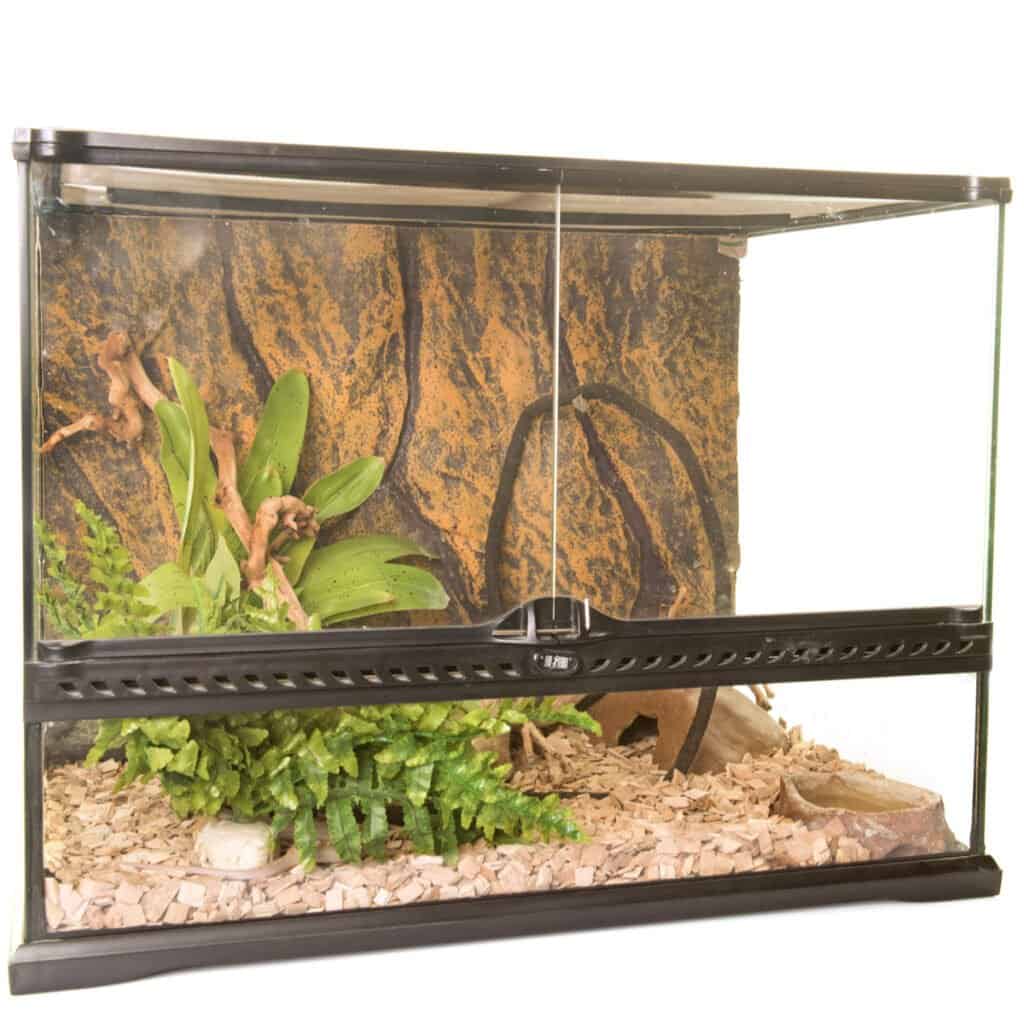
A tall terrarium is good for providing geckos with space to dig and climb for extra activity.
©cynoclub/Shutterstock.com
African fat-tailed geckos are simple and docile lizards that do not require lavish terrariums.
Tank Size
A new terrarium can be either a 20-gallon tank or a 36-inch long x 18-inch wide x 18-inch high. This will provide ample space for the gecko to run around comfortably and enjoy their natural decorations for hiding and sleeping.
Heat Source
African fat-tailed geckos are cold-blooded reptiles that use external sources of heat for energy. They need several types of lamps to regulate their body temperatures effectively. One side of the tank should have a hot spot ranging from 88–90 degrees Fahrenheit with the rest of the tank having a moderate feel of 78-82 degrees Fahrenheit.
Humidity
Use a spray bottle with clean, room-temperature water to keep the terrarium at a 50-70% humidity level. This is extra important as it helps the gecko keep their skin healthy and body temperature regulated.
Decor
Provide plenty of cover with rocks, caves, leaves, or branches so they can rest during the day. These geckos are nocturnal, so they will want plenty of spaces to hide from the light so they can rest comfortably. Fresh plants like creeping figs or calatheas are excellent options to help balance humidity and make the gecko feel more comfortable.
Substrate
Substrates of bark terrarium mat liners, or compressed coconut are excellent bedding options. The gecko can bury themselves in the bark or compressed coconut, as well as provide them with a more natural ground to walk on. Avoid using sand as a substrate. If the gecko eats an insect, it may accidentally swallow some sand as well. Sand is very bad for their digestion as it leads to impaction or blockage of their bowels.
Essential Items
Place two bowls within the terrarium, one filled with fresh water, and the other for food to house mealworms.
Stick a thermostat on each side of the terrarium where it can be easily seen. It should provide you with information on the temperature of both sides of the terrarium and humidity levels.
Geckos are very curious creatures and will explore their terrarium once they feel safe. Make sure there is a roof or topper to the terrarium to prevent them from escaping. Reptiles such as ball pythons, chameleons, and iguanas are intelligent enough to recognize the edges of their habitat and will try to open the tanks to explore.
African Fat-Tailed Gecko Diet
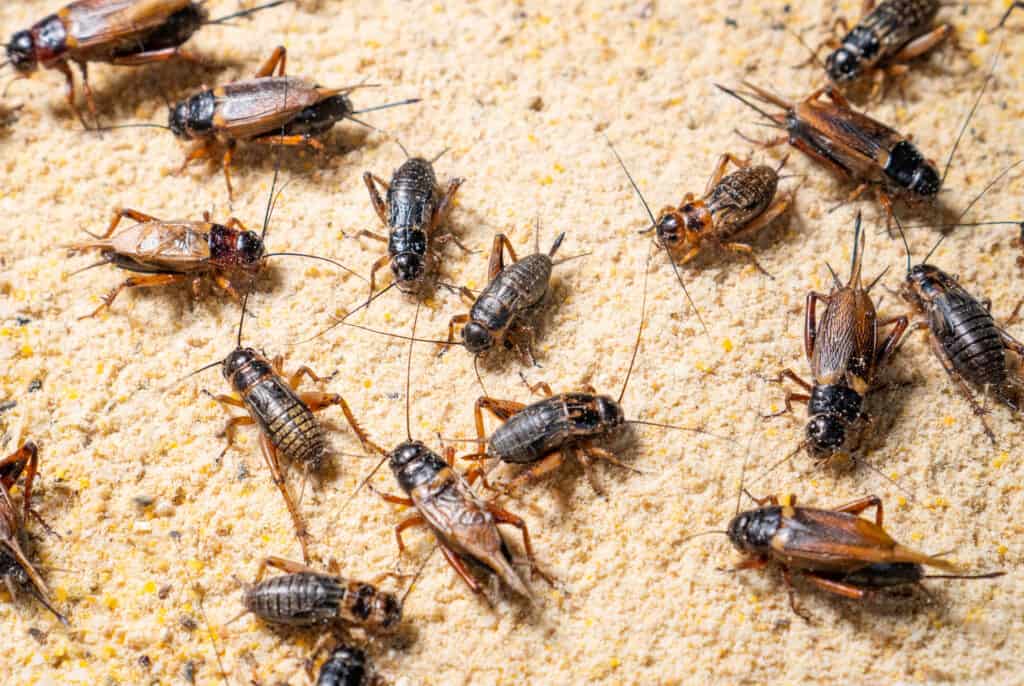
African fat-tailed geckos are insectivores, meaning they primarily eat insects like crickets, beetles, and various types of worms.
In the wild, they can catch prey readily enough, but much of their diet lacks specific vitamins and nutrients, leading to their lower lifespan in the wild.
In a terrarium, they should be fed five to nine small to medium-sized “dusted” crickets once a day or every other day. Dusted means that the crickets are covered in a supplement powder before being offered as food. Mealworms should also be dusted before being placed in a bowl for easy access.
Geckos must be given calcium and vitamin D3 powder to help maintain their metabolism. A diet of crickets and mealworms does not provide these vital nutrients, which is another cause of their shorter lifespans in the wild. Dusting their prey in calcium powder and vitamin D3 powder will increase their chances of living a healthy life substantially.
Alternatively, crickets can be “gut-loaded” where they engorge themselves on food before being offered to the gecko. Once the gecko eats the crickets, all the nutrients the cricket has eaten are transferred to the gecko through the digestion process.
Once the gecko is finished eating, remove any uneaten crickets and remove the mealworms so they do not harass the gecko when it is trying to digest and relax.
Keeping African Fat-Tailed Geckos Healthy
Before bringing an African fat-tailed gecko home, make sure the terrarium is ready. All the lights are ready, the temperature is set, the environment looks well put together, and there is fresh water in a clean bowl.
The gecko will take some time to become familiar with its new surroundings. Give them time to look around and understand they are in a safe environment, and nothing will harm them. The gecko may not eat for the first few days, which is normal as they have fat reserves in their tails to supplement them. Once they are comfortable enough with the terrarium, they will start eating normally.
During the adjustment period, do not try to handle or play with them just yet. Allow the gecko to acclimate first. Once they are eating and pooping consistently, then start introducing yourself with an open hand and small taps.
Always wash your hands before and after touching the gecko. They are very sensitive to bacteria and foreign substances that can lead to adverse health effects on their immune system or digestion.
Remove uneaten food or dead crickets so they do not sit and rot.
Spot-clean the terrarium by removing any feces immediately.
Deep clean the terrarium once a week or once a month. Place the gecko in a temporary holding cage while you thoroughly clean all four corners of the cage and replace the substrate. Use simple soap and water to remove any stains and bacteria. Do not use harsh chemicals like bleach as the scent can linger and negatively affect the gecko. Once the cage is clean, place the gecko back inside.
Signs of a Healthy Gecko
Geckos are not the most expressive creatures, but it is easy to tell when they are happy and healthy.
- Active and interacts with décor.
- Eating and drinking regularly
- Defecating every day or every other day
- Calm and docile
- Clear colors and healthy sheen
- Chubby and fat tail
Note that geckos will look pale when they are about to shed their skin. This is a normal process, and they will scratch against objects to remove the dead skin cells. Avoid touching them during this process as their skin is very delicate to germs and bacteria at this time. If they are having trouble shedding, bring them to an exotic animal doctor for assistance.
Signs of a Sick Gecko
If the gecko has any of these symptoms, schedule an appointment with an exotic animal doctor as soon as possible.
- Abnormal color feces (mute, dark, watery)
- Inactive and sluggish
- Loss of appetite
- Thin and shriveled tail
African fat-tailed geckos are an excellent pet for those interested in wanting to own a reptile for the first time. They require very little care outside of a well-maintained terrarium and properly dusted or gut-loaded crickets. They are very friendly and a great introduction to pet care for a new species.
The photo featured at the top of this post is © Kaan Sezer/iStock via Getty Images
Thank you for reading! Have some feedback for us? Contact the AZ Animals editorial team.



